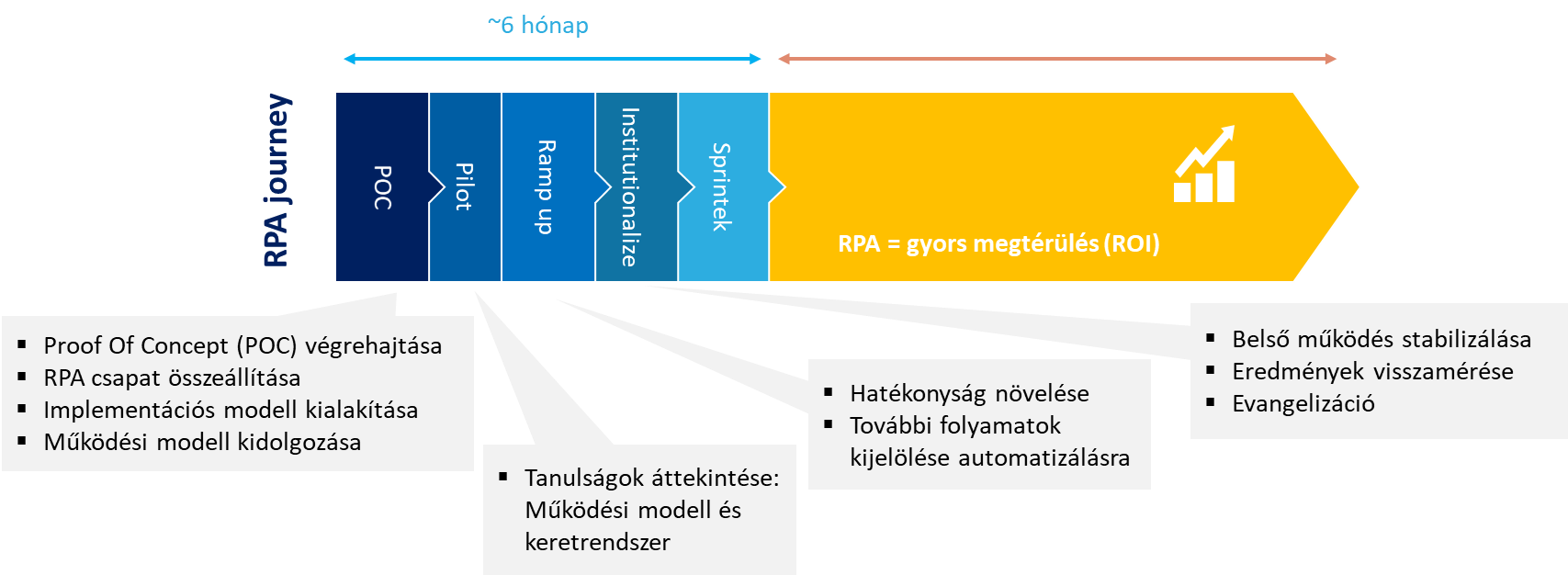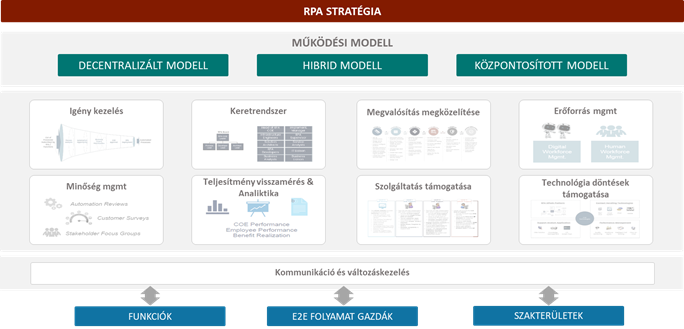Az RPA működési modell kialakításának 3 lépése

Gyakran felmerül a kérdés, hogy hogyan kell elképzelni az RPA bevezetést, mert üzleti oldalról nézve erősen technikainak tűnik, IT oldalról nézve, pedig erősebben üzlet-orientált. Mindegyik megközelítés közel áll a valósághoz.
Mi a UiPath RPA journey modelljét használjuk a gyakorlatban. Jelen blog sorozatunkban ennek a bevált gyakorlatát mutatjuk be. Az RPA Journey model sok szempontból más, mint egy tradicionális IT projekt. Ahogyan a lenti ábrán is látható, más fázisai vannak (Proof of Concept, Pilot, Ramp up, Institutionalize és Sprintek), és sokkal gyorsabb megtérülést eredményez a tradicionális IT projektekhez képest.

A sikeres és meggyőző PoC (Proof of Concept) után az RPA bevezetést tervező vállalatoknak az IT szakmai felkészülés folytatása mellett ki kell alakítaniuk az RPA működési modellt/governance-et. Jelen blog postunkban ezt a teendőt járjuk körbe.
Nézzük milyen főbb lépései vannak, hogyan néz ki a működési modell kialakítása BCA módra:
1. Előkészítés és részletes felmérés
Az előkészítés során szükséges a jelenlegi működés magas szintű megismerése, ezzel biztosítjuk, hogy a részletes igényfelmérés teljes körű és megfelelően célzott legyen. A részletes felmérés alatt gyűjtjük össze, egyeztetjük és dokumentáljuk mindazon információkat, igényeket, amely alapján a keretrendszer kialakítható. Az iteratív folyamat során felülről-lefelé megközelítést alkalmazunk, azaz a feladatokat magas szintről indulva lépésről-lépésre bontjuk le, részletezzük. Tapasztalataink alapján az így kialakuló részletes igényeket szintetizálni szükséges, hogy azok valóban teljeskörűen lefedjék a meghatározott célokat és kielégítsék a definiált koncepciót, valamint, hogy beazonosításra kerüljenek az esetleges igények közti ütközések, átfedések. Ebben a szakaszban végezzük el az igények kategorizálását és priorizálását a feladatok későbbi hatékonyabb végrehajtása érdekében.
2. Keretrendszer kialakítása
A projekt következő fázisában készítjük el a keretrendszer tervezetet az előzőleg felmért, részletes igénylistában összesített igények mentén: A kialakítás első lépésében meghatározásra kerül az automatizálás magas szintű folyamata, az egyes folyamati lépésekhez kapcsolódó szervezeti egységekkel, felelősségekkel, leszállítandókkal együtt.
3. A projekt scope és működési modell megtervezése
A magas szintű tervezet elfogadása esetében a főbb mérföldköveket és lépéseket alábontjuk, tovább részletezzük a RA(S)CI mátrixban, közösen ábrázoljuk a kapcsolódó szervezeti egységekkel, azok felelősségeivel, leszállítandókkal, tervezett átfutási idővel. A mátrix mellékleteként elkészül a folyamati lépések részletes leírása, az automatizálásért felelős szervezet és benne az egyes szerepkörök bemutatása, valamint a leszállítandók sablonja (template-je).
A hatékony működés érdekében ajánlást teszünk a CoE (Center of Excellence) kialakítására, valamint a megvalósításért felelős csapat összetételére (belső megvalósítás, kiszervezés vagy hibrid modell) bemutatva azok előnyeit, hátrányait. Elkészítjük az automatizáció bevezetésének megközelítését, további lépések meghatározását. Az alábbi ábrán a működési modellen belül kialakítandó feladatköröket foglaltuk össze:

Természetesen a governance kialakítás projekt terjedelme rugalmas, igény esetén magában foglalhat olyan lazábban kapcsolódó tevékenységeket, mint a bevezetésre javasolt UiPath komponensek és infra/architektúra opciók bemutatása vagy a fejlesztési legjobb gyakorlatok, szabályok meghatározása.
Így néz ki a gyakorlatban nálunk a működési modell kialakítása a UiPath RPA journey modell szerint, de minden ügyfél és projekt egyedi. Automatizálnád folyamataid? Lépj kapcsolatba velünk itt.
